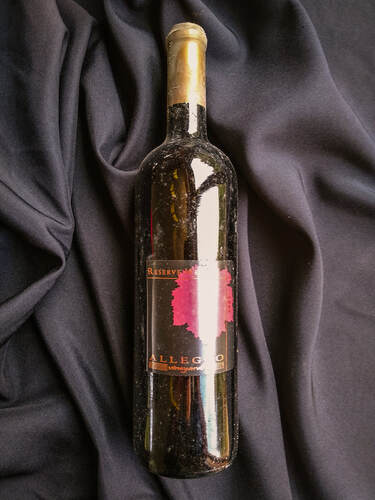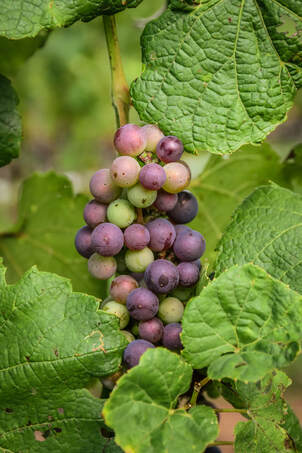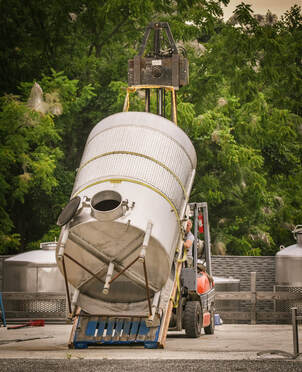 It was early September in 2002 when Carl got an unexpected call from Jan Waltz of Waltz Vineyards: Can I bring you your Merlot? Tonight? The reason this was so unexpected was because this variety, in a normal year, wouldn't be picked until early October. The 2002 growing season was a hot one, and these young vines (then in 4th leaf) had gained sugar quickly. During the second week of September they were measuring 24.8 Brix, which would ferment to 13.8% alcohol. In a normal year, young-vine Merlot would be picked at 22 or 23 Brix. This was not a normal year. Carl got the grapes. In mid-2003, tasting the wine in barrels, he was very aware of the wine's potential. The 3.25 barrels of 2002 Reserve Merlot were bottled in 2004. The wine is a blend of 11% Cabernet Franc and 89% of that luscious Waltz Merlot. We released the wine in August of 2004 at $25 per bottle. The labels (which I designed and now make me cringe a bit) were hand-printed. We had about 80 cases of the wine. It started to sell so quickly that we raised the price to $35 per bottle. And, just like that, it sold out. Gone. Except...for the 2002 Reserve Merlot reserved for the Allegro wine library. Every once in a while Carl turns a regular day into a special day by opening a special wine. Recently, we had one of those days, popping the cork on this now-18-year-old wine. Wow. This wine still holds its fruit core: What used to be a 100% raspberry quality has darkened a bit, but it still super-present. Time has added some bottle bouquet and earthiness, accompanying the wine's notes of cocoa and coffee. The wine has nice structure and tannins and is a perfect fit for an American palate: likeable, complex, still fruit-forward. Really outstanding. This wine is the same age as our son Dylan. Reflecting on this, Carl noted that it "makes me feel old, but not in a bad way." It definitely gives some perspective, to know that our son and this wine have both been alive for 18 years, developing and changing. (Carl notes that Dylan is still more complex than the wine.) So cheers to being able to enjoy some perspective, and to be able to capture and share the very best grapes from the very best vintages. Thanks to the magic of wine, we can literally taste time.
0 Comments
 On the hunt for a wine to pair with my mac 'n cheese recipe, I realized that Allegro currently has four Chardonnays on our roster. Here are a few notes on each, and on the differences among them: Blanc de Blanc: This wine is from Brad Knapp at Pinnacle Ridge Winery in Kutztown. He's a master of bubblies, and this light and crisp wine is wonderful with seafood. 2017 Cadenza Vineyards Chardonnay: Grown in the "Crouch Block" (the original Chardonnay planting) of our estate vineyards in The Brogue, this is a special wine. The wine was barrel fermented with stirred lees for 6 months, contributing to its full mouthfeel and what Carl calls its "supple richness with a complementary raciness." It has a definite oak character which is well balanced with its fruit. Definitely still young, this wine still has years of in-bottle flavor development in its future. Skin Chardonnay: This wine is a blend from Allegro's young vine Chardonnay grapes in 2017 and 2018. In the cellar, the wine was left in contact with its skins for a week. This is a process usually reserved for red wines, but in this instance it helps provide the young-vine fruit with more interest and complexity. The wine was aged in neutral oak barrels, giving it structure and balance. Carl says, "It's still Chardonnay, just turned up to eleven." 2019 Steel Chardonnay: This fruit was grown by Kris Kane of 21 Brix Winery in the Lake Erie region. Fermented in steel tanks rather than oak barrels, the wine is pretty straightforward, light and smooth. Unoaked Chardonnay doesn't usually have a ton of varietal character, just a nice soft peachy fruitiness. So...I found in the end that the Skin Chardonnay was the best companion to my mac 'n cheese dinner, but all of the Chardonnays in the family definitely have their place on the roster of summer food wines. Cheers!  In February, when Allegro purchased the land, buildings, and equipment of the former Naylor Wine Cellars in Stewartstown, we knew that we were on the cusp of big changes. Little could we have known how much the whole world would change over the course of the next months, as the pandemic hit the world and we all hunkered down. It felt strange to have put so much energy into ideas of expansion, only then to contract for a little while. Fortunately, we have managed to keep ourselves and the business safe, thanks to Carl's diligence with details large and small. One thing which hasn't changed, amid all of the upheaval in the world, is the fact that the vines have still grown and the grapes are still ripening. Harvest is coming, and in a world ripe with "Ready or Not"s, Carl would certainly rather be ready.  As Allegro's wine production continues to increase, our fermentation will now be split, with red wines to all be fermented at our crush pad at the winery in The Brogue and whites at the Stewartstown facility. That has meant a colossal shift in the tank inventories, as four 1500-gallon and two 800-gallon tanks from Stewartstown have come to The Brogue, while four 2000-gallon tanks have been moved in the other direction. One by one, the tanks have been moved, put upright, and are currently in the process of being put into place at their respective locations. This has meant lots of work for Dwayne with the forklift, and welding taking place before the tanks are moved to their pre-harvest crush pad destinations. So...it's a time of flux amid a greater time of flux, but it does feel good to see purposeful change and know that, accompanying the beginning of the change of seasons, we are readying ourselves for the coming harvest. It's a year unlike any other year, for Allegro as well as for the world, and the 2020 vintage will certainly always have a kind of asterisk by its notation. How strange it will be, years from now, to open a bottle of Allegro's 2020 red wine and remember all of this.
Yesterday afternoon, after the thunderstorm passed, I took a walk to the field and looked back to the winery and crush pad. Look what I saw...  I've heard it said many times that "Wines are made in the vineyard." While I understand the truth of this--that that winegrowing has a huge impact on the wines--I have also heard Carl say that, in some vintages, wine can be salvaged or lost, depending on what goes on in the cellar. He cites the 2018 Duet as a prime example of this. Some of our very worst years at Allegro, in terms of the growing season, were 2003, 2009, 2011, and 2018. 2018 was cold and wet from the beginning of the growing season to the end of harvest in October. It rained and rained and rained, even during harvest. The constant wetness can contribute to rot, low yields, and dilution of the grapes' juice. Care of the vintage in the vineyard was overseen by Allegro's vineyard manager, Nelson. Carl's care during the winemaking was also essential to the creation of a good wine, even in such a poor season. He notes that, a few years before 2018, we wouldn't have had the knowledge and skill to pull off such a good wine in such a challenging year. The fact that they succeeded with the 2018 Duet is something that he and Nelson can really be proud of. When our home ("estate") vineyard produces vinifera grapes, Carl considers whether the resulting wines will be of a quality level good enough to be bottled as a Cadenza wine. (Cadenza is the wine label which we only use for our best estate-grown wines.) From the 2018 vintage, the only decent estate-grown red grapes which we grew were the Petit Verdot (4 barrels) and Merlot (2 barrels). The Cabernet Sauvignon was a disappointment that year, unable to ripen adequately. While the Petit Verdot and Merlot weren't quite Cadenza-caliber quality, Carl did choose them to bring together in a nice "Duet," and the 2018 Duet is a testament to his winemaking skills.  In the cellar, Carl treated the Petit Verdot and Merlot royally, putting all 6 in expensive new French oak barrels. Their coming together as Duet married two wines with quite different characters, neither of them subtle. The 4 barrels of PV were marked with what Carl calls "brash fruitiness," with a rustic quality and definite tannins and acidity. The 2 barrels of Merlot were a "fruit bomb," with enough body to bring that fruit forward and round out the flavor of the blend. Together in Duet (64% PV and 36% Merlot in the finished wine), the two grape varieties definitely found harmony. So, with the backstory in mind, when I drink Allegro's 2018 Duet I can't help but admire all of the hard work--the "duet" of winegrowing and winemaking skill sets--which went into making a quite fine "lemonade" out of a real lemon of a year. |
Archives
March 2021
Categories |




 RSS Feed
RSS Feed